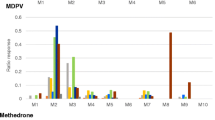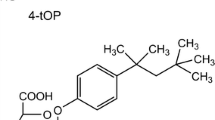Summary
The metabolism of tramadol was investigated in vitro using microsomal fractions of human liver. The parent compound and its main metabolites were determined by a newly developed high performance liquid chromatography assay. O-demethylation of tramadol was found to be stereoselective. The Vmax of the O-demethylation of (−)-tramadol was 210 pmol·mg−·min−1, whereas (+)-tramadol was O-demethylated with a Vmax of 125 pmol·mg−1·min−1. The Km for both enantiomers was determined to be 210 μM. O-demethylation was inhibited competitively by quinidine (ki=15 nM) and propafenone (ki=34 nM). N-demethylation was also stereoselective, preferentially metabolizing the (+)-enantiomer. Whereas O-demethylation displayed monophasic Michaelis-Menten kinetics, N-demethylation was best described by a two-site model. Competitive inhibition of the O-demethylation both by quinidine and propafenone suggests that O-demethylation is carried out by P-450IID6.
Similar content being viewed by others
Abbreviations
- HPLC:
-
high performance liquid chromatography
- ki :
-
inhibitory constant
- km :
-
apparent Michaelis-Menten constant
- M1:
-
O-demethylated metabolite of tramadol
- M2:
-
N-demethylated metabolite of tramadol
- NADP:
-
nicotinamide-adenine dinucleotide phosphate
- T:
-
tramadol
- vmax :
-
maximum velocity of the reaction
References
Dayer P, Gasser R, Gut J, Kronbach T, Robertz GM, Eichelbaum M, Meyer UA (1984) Characterization of common genetic defect of cytochrome P-450 function (debrisoquinesparteine type polymorphism)-increased Michaelis constant (km) and loss of stereoselectivity of bufuralol 1-hydroxylation in poor metabolizers. Biochem Biophys Res Commun 125:374–380
Eichelbaum M, Gross AS (1990) The genetic polymorphism of debrisoquine/sparteine metabolism — clinical aspects. Pharmacol Ther 46:377–394
Eichelbaum M, Spannbrucker N, Dengler HJ (1978) A probably genetic defect of the metabolism of sparteine. In: Gorrod JW (ed) Biological oxidation of nitrogen. Elsevier North-Holland, Amsterdam, pp 113–118
Kroemer HK, Mikus G, Kronbach T, Meyer UA, Eichelbaum M (1989) In vitro characterization of the human cytochrome P-450 involved in polymorphic oxidation of propafenone. Clin Pharmacol Ther 45:28–33
Lintz W, Erlacin S, Frankus E, Uragg H (1981) Metabolismus von Tramadol bei Mensch und Tier. Arzneimittelforschung/Drug Res 31:1932–1943
Meyer UA (1990) Genetic polymorphisms of drug metabolism. Fundam Clin Pharmacol 4:595–615
Osikowska-Evers BA, Eichelbaum M (1986) A sensitive capillary GC assay for the determination of sparteine oxidation products in microsomal fractions of human liver. Life Sci 38:1775–1782
Otton SV, Crewe HK, Lennard MS, Tucker GT, Woods HF (1988) Use of quinidine inhibition to define the role of the sparteine/debrisoquine cytochrome P450 in metoprolol oxidation by human liver microsomes. J Pharmacol Exp Ther 247:242–247
Author information
Authors and Affiliations
Rights and permissions
About this article
Cite this article
Paar, W.D., Frankus, P. & Dengler, H.J. The metabolism of tramadol by human liver microsomes. Clin Investig 70, 708–710 (1992). https://doi.org/10.1007/BF00180294
Received:
Revised:
Accepted:
Issue Date:
DOI: https://doi.org/10.1007/BF00180294




